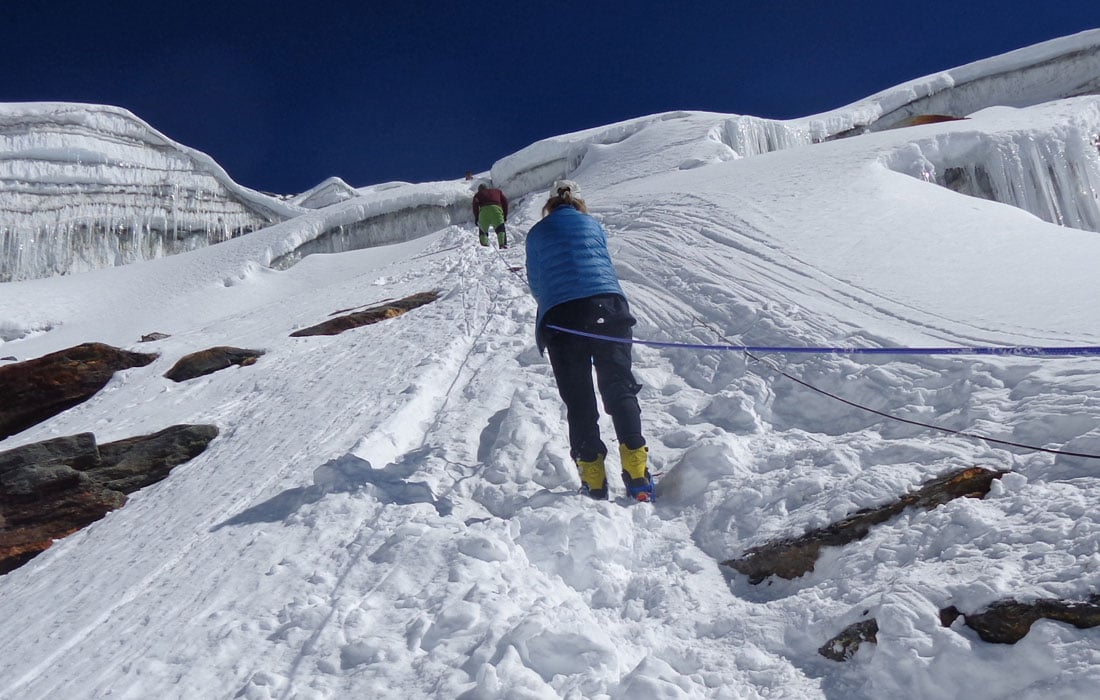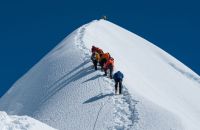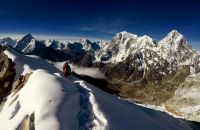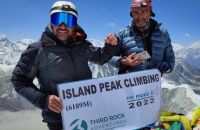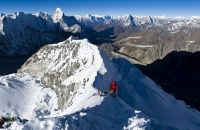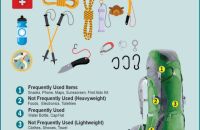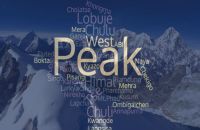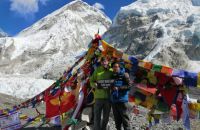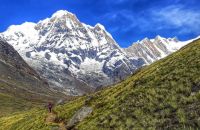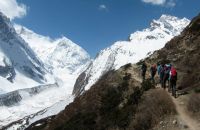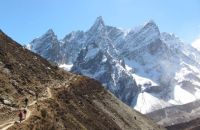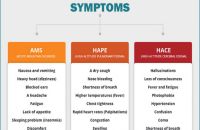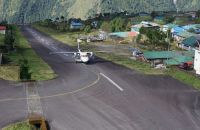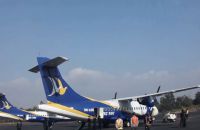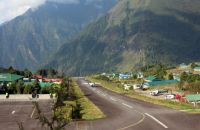Talk with our local travel specialist who can help organize your trip.
Packing List For Peak Climbing in Nepal
Table of Content
The peaks in Nepal which range in altitude between 5,800m to 6,584m are designated as trekking peaks. The time taken to reach the summit of these peaks is very short. You only camp for a night or two at the base or high camp and descend down to the nearest village or settlement after reaching the summit. But even though the climbing days are much shorter, it’s important to scale the mountain using high-quality gear and equipment.
We reckon a ready-made packing list for climbing in Nepal will be helpful and save you time plus energy, especially if you are a novice climber. So that you do not miss out on the essential items for your peak climbing adventure in Nepal, we have compiled a comprehensive list of gear and equipment.
However, please do bear in mind that this is a tentative list and you won’t be needing all the items listed below. The timing (season) and duration of your adventure, weather, variation in elevation and your personal needs should be taken into consideration while packing for your trip.
Conducting a little research on your own, checking for the day-to-day temperatures and weather patterns while creating your personal packing list will help you in many ways. It will save you a lot of space in your luggage and an extra baggage fee.
Your porter will carry your luggage but you are required to carry a day-pack (with your valuables or anything important) on your own. While climbing, all the heavy camping gear and equipment (tents, ropes, food supplies, utensils, etc.) will be carried by the sherpas. You carry your camera, snacks and other accessories in a light day-pack.
Before heading to the mountains, you can leave your spare luggage at your hotel. Every hotel in Kathmandu offers locked storage which is completely safe and free. But make sure that you lock your luggage before leaving it at storage.
Most of the items listed below can easily be hired and bought in Kathmandu. Thamel in Kathmandu has many shops selling branded as well as locally made trekking and climbing gear and equipment. Please do note the list given below is just a guideline to help you pack for your adventure. You can use it as a reference to customize your packing list as per your needs.
Suggested Read: Top 10 Tips To Summit Island Peak: Most Popular Trekking Peak In Nepal
Important Documents And Items
- Passport with 6 months validity, 2 passport size photos, airline tickets
- Separate photocopies of passport, visa form (easily obtained at Kathmandu airport), proof of insurance
- Dollars, Pounds or Euros in cash for purchasing Nepalese visa at Kathmandu airport, for paying for restaurants and hotels, for gratuities, snacks, and to purchase your own drinks and gifts
- Credit card, Bank/ATM/Cash machine cards for withdrawing funds from cash machines (bring a photocopy of your cards), traveler's cheques, etc.
- Nepalese currency to buy snacks and other items on the trail
Must Read: Climbing Gear List For Lobuche Peak
Personal Climbing Gears
- Ice axe
- Crampons
- Harness
- Screwgate karabiners (2 locks, 2 unlock)
- Descender/eight figure
- Plastic mountaineering boots
- Ascender/Jhumar
- Helmet
Group Climbing Gears
- Snow bar
- Rope
- Ice hammer
- Ice screw
Personal Trekking And Climbing Gear Checklist
Rucksack and Travel Bags
- A small daypack/backpack(30-40L) for carrying your valuables should have good shoulder padding.
- Large duffel bag (80-100L)
- Small padlocks for duffel-kit bags
- Waterproof covers
Head
- Bandana or headscarf, very useful for dusty conditions
- Balaclava that covers your ears
- Beanie
- Wide brimmed sunhat
- Neck gaiter or warmer
- Headlamp with extra batteries and bulbs
- Snow goggles and Sunglasses with UV protection (carry an extra pair in case you lose or break it)
- Prescription sunglasses (if required)
Upper Body
- Long sleeve shirt (moisture absorbing and breathable)
- T-shirt (moisture absorbing and breathable)
- The thermal base layer of merino wool
- Fleece wind-stopper jacket or pullover
- Waterproof (preferably breathable fabric) shell jacket
- Down Vest
- Expedition weight insulated down jacket with hood (not required for all trekking peaks )
- Gore-Tex jacket with hood, waterproof and breathable
Hands
- A pair of lightweight poly-liner gloves or lightweight wool or fleece gloves
- Summit Mittens (warm insulated gloves with safety straps)
Lower Body
- Non-cotton underwear briefs
- Hiking shorts
- Lightweight thermal leggings of merino wool
- Trekking trousers (waterproof, breathable fabric)
- Hardshell trousers
- Synthetic insulated pants
Feet
- Double insulated climbing boots
- Good quality hiking boots (sturdy soles, water-resistant, ankle support, “broken-in”)
- Gaiters
- Crampons
- Lightweight inner socks, heavy poly or wool socks and cotton socks
- Running shoes and rubber sandals/flip-flops
Sleeping
- Sleeping Bag ( a 5 season sleeping bag, suitable for temperatures for as low as -40°C)
- Therm-a-Rest sleeping pad (NeoAir XTherm) which offers insulation and warmth in sub-freezing temperatures
- Foam pad
- Fleece sleeping bag liner
- Pillowcase
Medical
- Small, personal first-aid kit (simple and light)
- Aspirin, first-aid tape, and plasters (Band-Aids)
- Skin-blister repair kit
- Anti-diarrhea pills
- Paracetamol
- Cough and/or cold medicine
- Anti-altitude sickness pills - Diamox or Acetylzolamide
- Stomach antibiotic - Ciprofloxacin, etc. Do not bring sleeping pills as they are a respiratory depressant.
- Throat lozenges
- Water purification tablets or the water filter
- Earplugs
- lip guard
- Eye drops
- Extra pair of prescription glasses, contact lens supplies
- Sunscreen
Practical Items
- Small roll of repair tape, sewing-repair kit
- Cigarette lighter / small box of matches
- Compass or GPS(optional)
- Alarm clock/watch
- Camera with extra SD cards and batteries
- Large Ziploc bags
- 2 water bottles (1 liter each)
- Lightweight steel thermal bottle
- Small folding or Swiss knife
- Binoculars (optional)
- 4 large, waterproof, disposable rubbish sacks
- Socket adapter Type C (with circular pins)
- Trekking poles(foldable)
Toiletries
- Medium-sized quick-drying towel
- Toothbrush/paste (preferably biodegradable)
- Multipurpose soap (preferably biodegradable)
- Small sachets of shampoo
- Deodorants
- Nail clippers
- Face and body moisturizer
- Female hygiene products
- Small mirror
Personal Hygiene
- Wet wipes (baby wipes)
- Tissue /toilet roll
- Anti-bacterial handwash
- Hand sanitizer
- Pee Bottle (1 litre, leak-proof, wide mouth)
- Pee funnel (for female)
Extras/Luxuries
- Reading book
- Trail map/guide book
- Journal and pen
- iPod
- Playing cards (to help you pass the time at teahouses and/or camps)
- A modest swimsuit
- Binoculars (optional)
Sleeping bag and liner, down jacket, trekking poles, gaiters, crampons, backpack etc. can be rented or bought in Kathmandu. Mountaineering boots of size 12 and above are very hard to find in Nepal. So if you have large feet (+12 size), you might as well bring your climbing boots from home.
Seasonal Temperature Chart
A seasonal temperature chart for Nepal that might help you pack for your Nepal peak climbing adventure. The listed temperatures are in Celsius.
|
Altitude |
Spring March, April, May |
Autumn Sept, Oct, Nov |
Winter Dec, Jan, Feb |
|||
|
|
Max. |
Min. |
Max. |
Min. |
Max. |
Min. |
|
1000m |
37 |
10 |
35 |
10 |
24 |
6 |
|
1500m |
33 |
9 |
34 |
7 |
22 |
4 |
|
2000m |
28 |
5 |
28 |
6 |
20 |
2 |
|
2500m |
25 |
2 |
25 |
5 |
18 |
-1 |
|
3000m |
22 |
1 |
20 |
0 |
16 |
-2 |
|
3500m |
18 |
0 |
18 |
-3 |
14 |
-4 |
|
4000m |
17 |
-2 |
12 |
-4 |
12 |
-7 |
|
4500m |
16 |
-4 |
11 |
-5 |
10 |
-6 |
|
5000m |
14 |
-6 |
10 |
-8 |
6 |
-12 |
|
5500m |
-4 |
-20 |
-5 |
-21 |
-13 |
-26 |
|
6000m |
-7 |
-23 |
-8 |
-24 |
-16 |
-29 |
|
6500m |
-12 |
-27 |
-12 |
-27 |
-19 |
-32 |
- Written by: Naba Raj Amgai
- Updated: Sunday Feb 5, 2023

